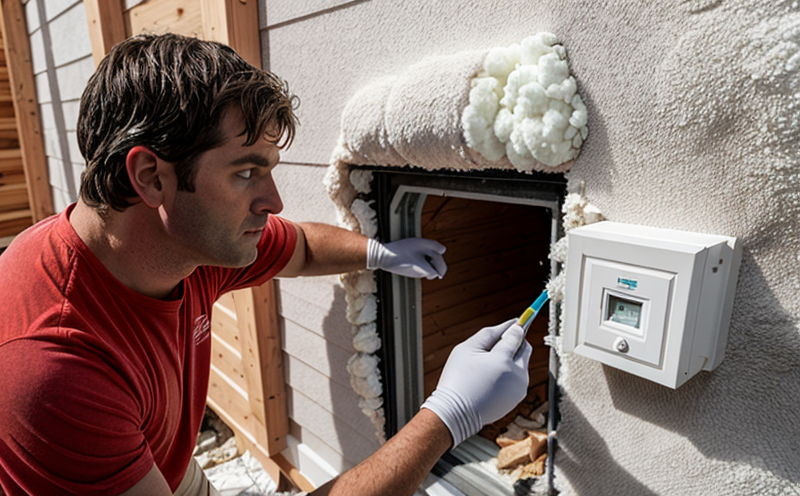ASTM C177 Guarded Hot Plate Method for Insulation
The ASTM C177 guarded hot plate method is a standardized procedure used to determine the thermal conductivity of insulating materials, including foams, fibres, and other similar products. This test is critical in the building and infrastructure sectors as it helps ensure that insulation materials perform optimally under various environmental conditions.
Thermal conductivity measures how efficiently heat can pass through a material. In the context of insulating materials, this value is essential for designing energy-efficient buildings and ensuring compliance with international standards such as ISO 8301-2. Understanding these parameters allows architects, engineers, and quality managers to select appropriate insulation types that meet specific project requirements.
The ASTM C177 method employs a guarded hot plate apparatus where the specimen is placed between two plates. One of these plates is maintained at a constant temperature while the other is held at a lower temperature. The heat flow through the specimen is measured using thermal sensors, and this data is used to calculate the thermal conductivity.
For accurate results, it's important to prepare specimens correctly according to ASTM C177 guidelines. Specimens should be cut from larger blocks or sheets of insulation material, ensuring uniform thickness and size. Proper preparation ensures consistent test conditions and reliable results.
The guarded hot plate method is widely used in the R&D departments of manufacturing companies where new materials are being tested for their thermal performance. It also plays a crucial role in quality assurance processes at various stages of production, from raw material selection to final product testing.
Understanding the ASTM C177 method can help stakeholders make informed decisions about insulation choices based on performance data. Compliance with this standard ensures that products meet regulatory requirements and contribute positively to energy-efficient buildings.
Customer Impact and Satisfaction
The ASTM C177 guarded hot plate method provides significant benefits for customers in the building and infrastructure sectors. By ensuring that insulating materials meet strict thermal performance criteria, this test enhances customer satisfaction by delivering reliable, energy-efficient solutions.
Quality managers can use ASTM C177 results to verify product specifications during procurement processes. Compliance officers gain assurance that their suppliers adhere to industry standards, promoting trust within supply chains. R&D engineers benefit from detailed thermal conductivity data which helps refine material formulations and improve insulation performance.
For manufacturers, the method ensures consistent quality across production batches, reducing defects and enhancing brand reputation. In turn, this improves customer satisfaction by delivering high-quality products that meet or exceed expectations for energy efficiency.
In addition to these direct impacts on customers, ASTM C177 also contributes indirectly through its contribution to broader sustainability goals. Buildings with well-insulated envelopes using materials tested according to ASTM C177 consume less energy, reducing both operational costs and carbon footprints.
Environmental and Sustainability Contributions
The ASTM C177 guarded hot plate method plays a vital role in promoting environmental sustainability by ensuring that insulating materials are selected based on robust thermal performance data. This contributes to reduced energy consumption in buildings, thereby lowering greenhouse gas emissions associated with heating and cooling.
By adhering to ASTM C177 standards during the design phase of construction projects, architects and engineers can specify insulation products that offer optimal thermal resistance without compromising structural integrity or aesthetics. This not only leads to more sustainable buildings but also supports global efforts towards reducing energy consumption in built environments.
The method also encourages innovation within the industry by providing a framework for continuous improvement of insulating materials. As manufacturers strive to develop new products that meet stricter thermal conductivity requirements, they contribute positively to advancements in green technologies and practices.
Additionally, ASTM C177 supports regulatory compliance which is essential for businesses operating in diverse geographic locations. Ensuring that insulation materials comply with local regulations helps protect the environment while fostering economic growth through efficient use of resources.
Use Cases and Application Examples
| Application Case | Description |
|---|---|
| Determining Thermal Conductivity of Insulation Materials | The ASTM C177 method is used to measure the thermal conductivity of insulating materials such as foams, fibres, and other similar products. This data is crucial for selecting appropriate insulation types that meet specific project requirements. |
| Evaluating Energy Efficiency in Buildings | By ensuring that insulating materials perform optimally under various environmental conditions, ASTM C177 helps designers and engineers evaluate the energy efficiency of buildings. This ensures compliance with international standards like ISO 8301-2. |
| R&D Material Testing | The method is essential in R&D departments where new materials are being tested for their thermal performance. It provides detailed thermal conductivity data which helps refine material formulations and improve insulation performance. |
| Quality Assurance Processes | In quality assurance processes at various stages of production, ASTM C177 ensures consistent quality across production batches by verifying product specifications. This reduces defects and enhances brand reputation. |
| Supply Chain Compliance | Compliance officers use ASTM C177 results to verify that suppliers adhere to industry standards, promoting trust within supply chains. This ensures that products meet regulatory requirements and contribute positively to energy-efficient buildings. |
| Sustainability Initiatives | The method supports broader sustainability goals by ensuring that insulation materials are selected based on robust thermal performance data. This contributes to reduced energy consumption in buildings, thereby lowering greenhouse gas emissions associated with heating and cooling. |





